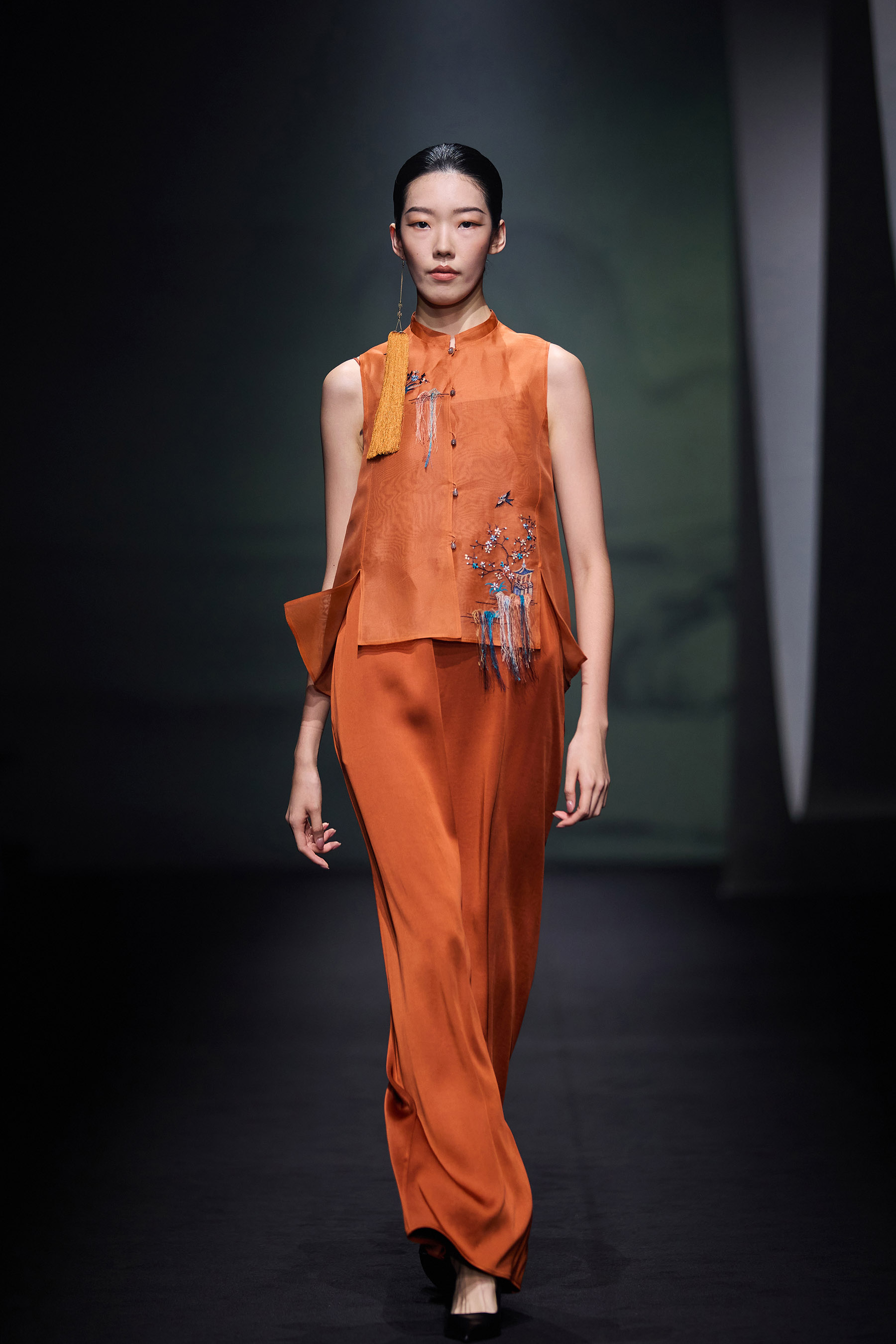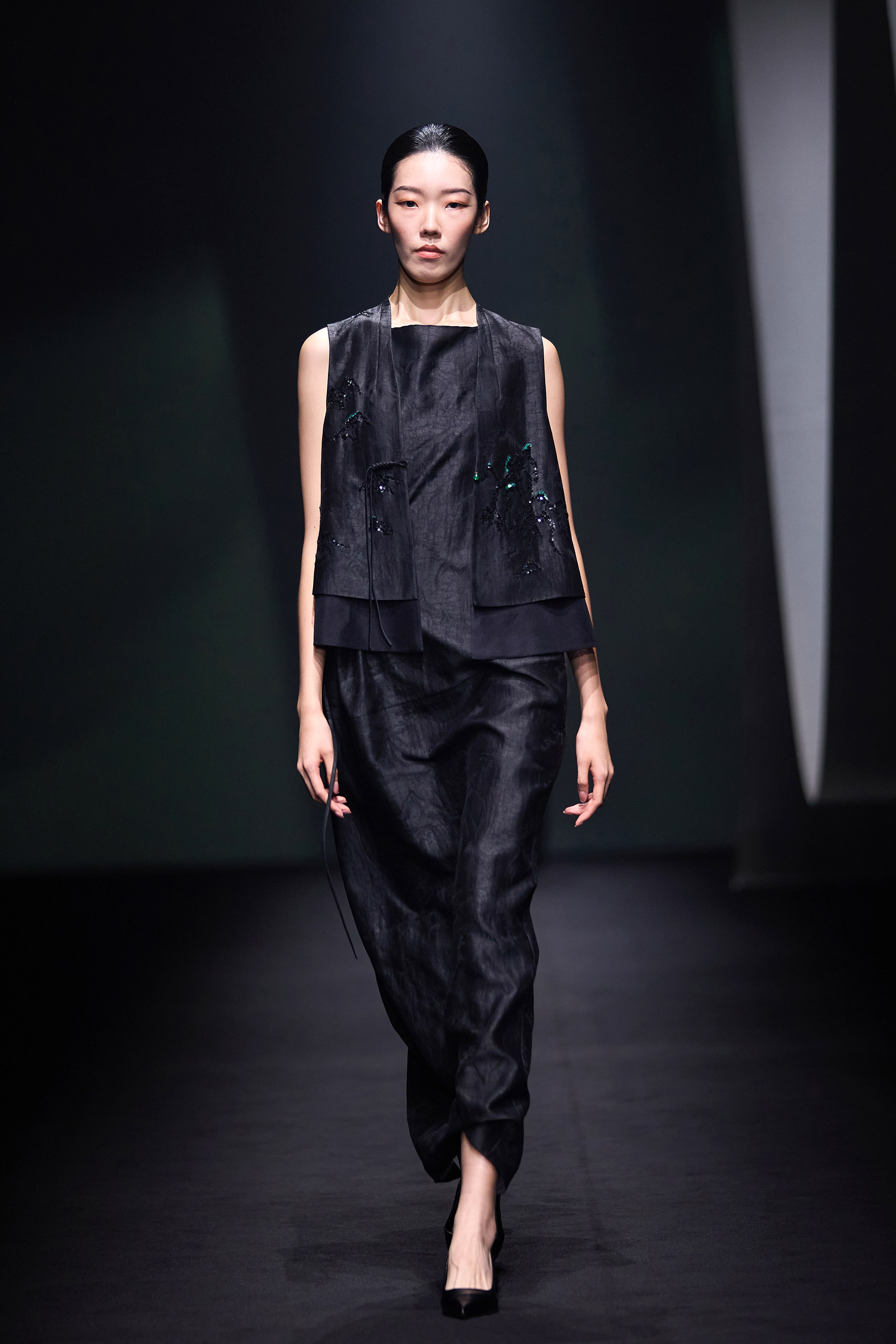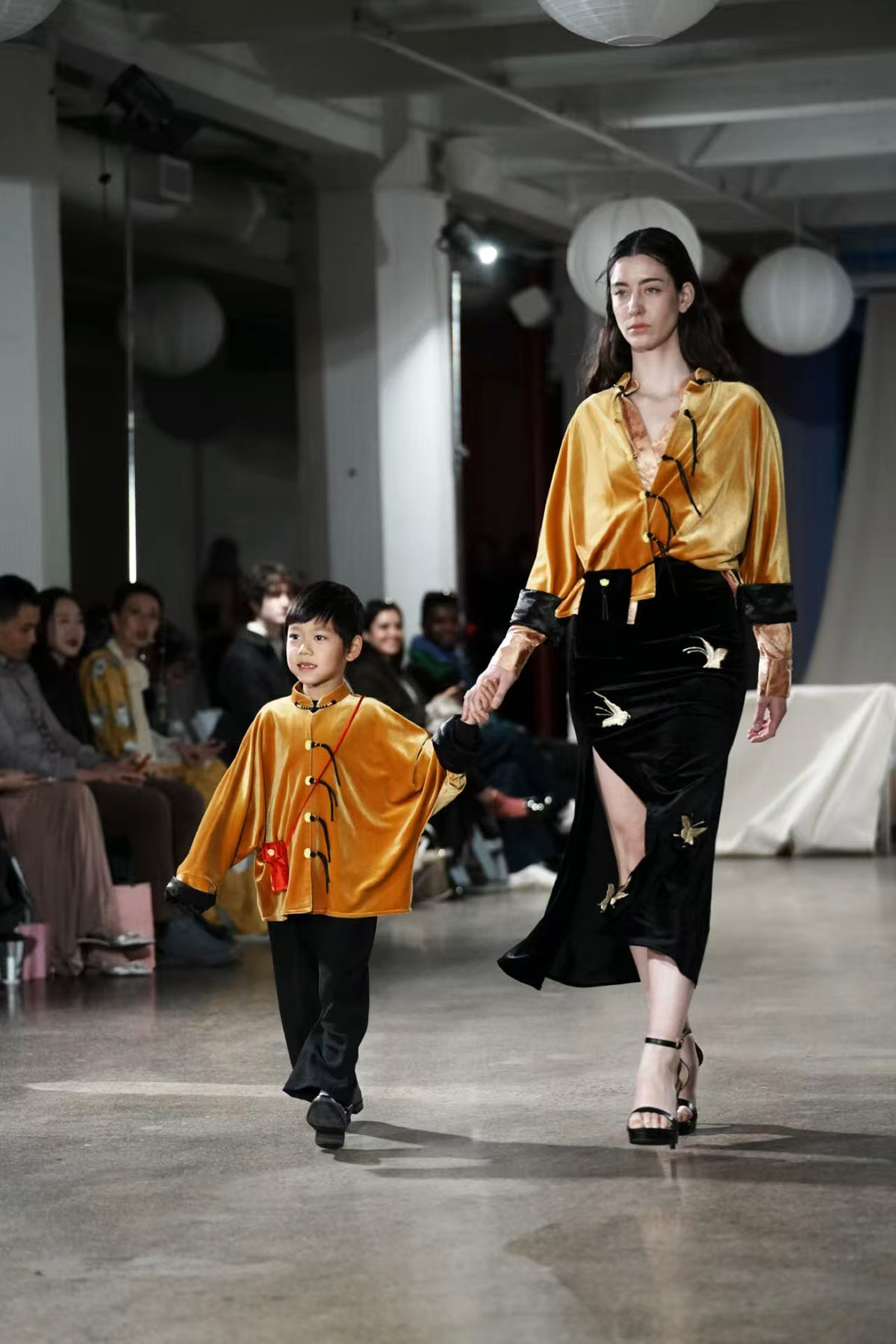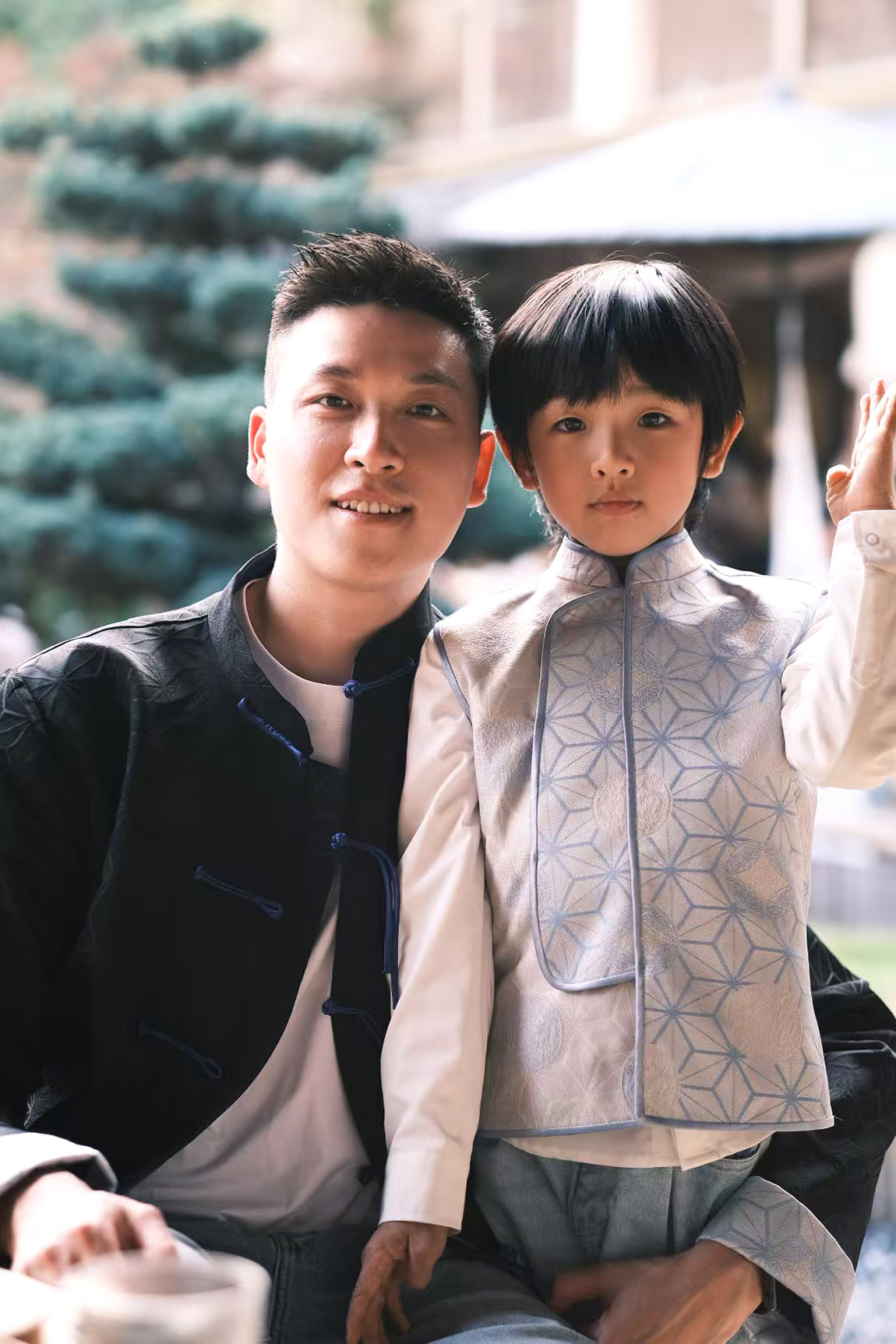Haipai qipao culture evolves into modern day with fresh structure and versatile fabrics, making it the perfect wardrobe piece for casual or formal occasions, He Qi reports.

Wang Wenxi, a 90s-born Chinese designer, debuted her brand FayWeaver at the 2025 Fall/Winter New York Fashion Week, stunning the audience with models walking the runway in reimagined Shanghai-style qipao (or cheongsam). Wang's designs feature diagonal plackets with traditional buttons paired with asymmetrical cuts, sleek lines defined by stretchy lycra fabric, and children's designs that swayed gently with each step.
As a young Chinese qipao brand established in 2021, FayWeaver's show raised a critical question: When the elegance of "Oriental Paris" meets the lifestyle philosophy of Generation Z (those born from the mid-1990s to the early 2010s), how can the Shanghai-style qipao emerge from the folds of history to become a dynamic cultural symbol?
Journey through history
The qipao, a quintessential symbol of Chinese attire revered in modern times, has journeyed through history influenced by diverse cultures such as the nomadic traditions of the Manchu and Mongolian ethnic groups, Han culture, and modern Western influences.
However, in its transition into the modern era, the Shanghai-style qipao played a crucial role. As described in the book The History of Chinese Qipao Culture by Professor Liu Yu from Donghua University: "Shanghai-style qipao epitomizes the qipao of the early 1900s. If we dare to go further, we could assume that modern qipao, or qipao in the narrow sense, is essentially Shanghai-style. This is because, in the minds of most people, the term 'qipao' evokes images of Shanghai-style qipao from the 1930s and 40s."
READ MORE: A cultural expression
In the early 1920s, female students in Shanghai sparked a fashion revolution by adopting qipao and breaking away from traditional norms. Born from the open social ethos of the time and Shanghai's unique geographic and cultural landscape, the Shanghai-style qipao emerged as a new genre of fashion and an ideological statement.
"Initially unadorned, loosely cut, and resembling Han men's robes, the Shanghai-style qipao served as a 'battle robe' inspired by men's attire," explains Liu, a scholar specializing in Shanghai-style qipao. It was a cry for gender equality, expressing inner aspirations through an outward appearance — a symbol of female independence and liberation."

This boundary-breaking spirit established the "East-meets-West" foundation of the Shanghai-style qipao's aesthetic. While preserving six intangible cultural heritage crafting methods — binding, insertion, piping, decorative edging, frog closures, and embroidery — it introduced three-dimensional Western tailoring, using waist and bust darts to outline the female figure and transform the traditional flat garment into a structured silhouette. These techniques turned the qipao into wearable cultural heritage," Liu notes.
By the 1930s, Shanghai-style qipao had pushed this fusion to new heights: high collars paired with ruffled edges, long hems with short jackets, and imported georgette fabric contrasted with traditional Yunjin brocade.
"Shanghai-style qipao exhibited stable yet ever-changing varieties, with constant fluctuations in length and collar height — any oversight could easily lead to obsolescence," Liu observes. This keen sense of trends made Shanghai the "Oriental Paris" in fashion, transforming the qipao from an elite garment into a universal fashion trend. As seen in old photographs, both celebrities and factory workers wore qipao to express individuality, making it a symbol of both cosmopolitan glamor and everyday urban life.

From runway to daily wear
FayWeaver's design philosophy rejects the stereotype that qipao is meant only for formal occasions. The brand's "commuter qipao" is shortened to just above the knee and made from wrinkle-resistant acetate fabric, with detachable frog button brooches that allow working women to exude cultural elegance while remaining comfortable.
The sportswear series is even more revolutionary — stretchy lycra fabric combined with modified standing collars enables movements in yoga, cycling, and other activities. There are even pet-themed qipao-inspired outfits to fit modern lifestyles.
"Wearing a qipao can be as easy as how you feel in the moment; breathable and flexible for lounging on the couch or chic and elegant for a night of entertaining friends," Wang states.
Wang's designs are made with a range of premium Chinese fabrics, such as gambiered Guangdong gauze, silk charmeuse, jacquard Luo silk, Songjin brocade, and mulberry silk satin. In addition to ready-to-wear pieces handmade by qipao artisans, custom options cater to diverse tastes and body types.
"As a young brand, we can experiment at our will, breaking boundaries to cater to women and of all ages, children, and even pets," says Wang. "By integrating traditional qipao craftsmanship with modern aesthetics and lifestyles, we hope more people will understand, appreciate, help design, and wear qipao."
Designer Tan Yanping's brand Leaves Fashion has created a series for various scenarios — business, day-to-day, and evening. Business styles are made using structured wool-blend fabrics with back slits to sit comfortably; daily styles incorporate cotton and linen for a relaxed feel; evening styles feature intricate frog buttons that re-create the glamour of 1930s social events.
"We balance inheritance and innovation," Tan explains. "We inherit craftsmanship. For example, we collaborate with Shanghai's Gu embroidery artisans and traditional button-makers. But the overall style must adapt to modern lifestyles, as fashion is constantly evolving."
Tan further explains that today's younger generation loves clothing with traditional elements, "Those who haven't tried them just haven't found the right fit yet."

Designed for competition
The promotion of haipai, or Shanghai-style qipao culture, not only involves the continuous participation of young people and active brands but also the impetus of social organizations behind it.
The 3rd Innovative Haipai Qipao Design Competition kicked off at the Shanghai University of Engineering Science last month. Aimed at exploring and inheriting the integration of Atlas silk, a precious intangible cultural heritage craft, and haipai qipao culture, the contest focuses on college students' designs, builds a platform for cultural exchange and innovation to engage more young people in learning, and carries forward traditional culture.
The competition received 1,021 designs from 76 domestic and international universities, including those from France, the United States, South Korea, and Morocco, as well as 16 enterprises and nine independent designers.
The annual Haipai Qipao Culture Festival launched in Zhang Yuan, or Zhang Garden, in June. Data show its events, including qipao shows and sales, drew over 120,000 participants, boosting surrounding consumption by 40 percent, according to CCTV News.
ALSO READ: Jilin's Qipao Hall preserves ancestral threads
Shen Huiqin, president of the Shanghai Haipai Qipao Culture Promotion Association, notes that the festival also hosts an annual qipao design contest, with over 1,500 innovative designs already submitted in 2025. Multiple exhibitors highlighted the rapid growth of the qipao market, with domestic sales registering an average annual growth rate exceeding 10 percent. High-end custom qipao can fetch tens of thousands of yuan each, while innovative products for mid-to-low-end markets thrive.
Professor Liu asserts that modern Shanghai-style qipao are refined with darts, waist and bust shaping, and an adjusted shoulder and underarm fit for comfort and style, reflecting their evolution with contemporary women's lives.
"Over a century ago, the qipao was a fashion item, but we should not relegate it to formal wear or uniforms. If it was a fashion staple for women in the past, we have even more reasons to revive it as a modern fashion piece," Liu says, adding on that today's qipao can be paired with jeans, casual pants, or sneakers.
"The essence of the Shanghai-style qipao lies in keeping pace with the times. Tradition must be innovated to be preserved, and innovation enables better inheritance."
Contact the writer at heqi@chinadaily.com.cn


